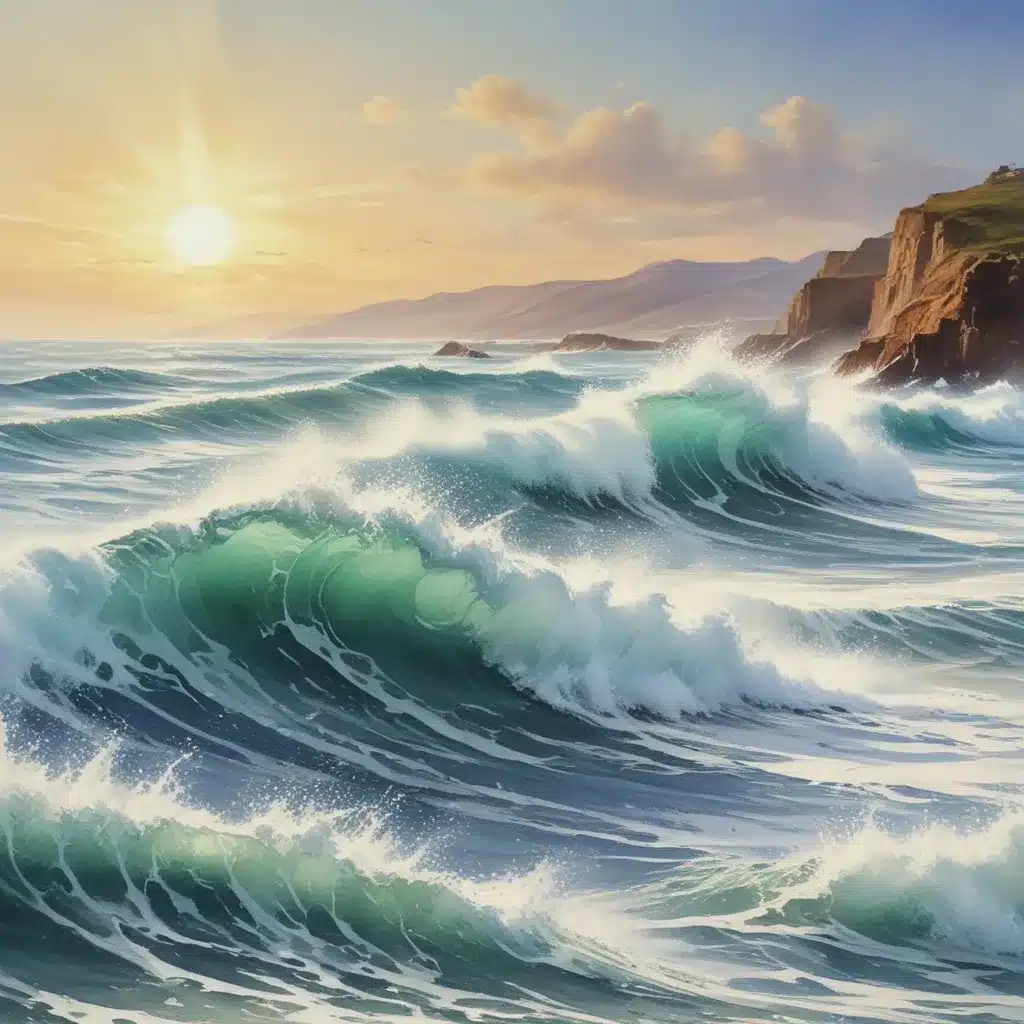
The boundless energy and captivating beauty of the ocean have long inspired artists to capture its essence on canvas. As a watercolor painter, harnessing the fluid, ever-changing nature of this subject can be both exhilarating and challenging. However, with the right techniques and creative approach, you can breathe life into dynamic ocean scenes that evoke the power and serenity of the sea.
Colour Theory for Watercolour Waves
When it comes to painting the ocean, colour is key. Water reflects the surrounding environment, so the hues you choose can drastically affect the mood and realism of your work. Start by observing the diverse range of blues, from deep navy to shimmering cerulean, that characterize the ocean’s depths. These cooler tones can be enhanced with touches of warmer pigments, such as raw sienna or quinacridone gold, to capture the play of light on the water’s surface.
Equally important are the whites and greys that represent the dynamic crests of waves. Experiment with lifting and layering these lighter values to achieve a sense of movement and frothy texture. Don’t be afraid to introduce unexpected pops of colour, like the soft lavenders and turquoises that can appear in the shadows and highlights of the waves.
Mastering Watercolour Technique
Painting realistic yet expressive watercolour waves requires a delicate balance of control and spontaneity. Begin by establishing a strong foundation with a detailed pencil sketch, capturing the overall composition and key shapes of your scene. Then, gradually build up your layers of colour, starting with the lightest values and gradually adding depth and detail.
One effective technique is to use wet-on-wet washes to create the illusion of water’s fluid motion. Fully saturate your paper with clean water, then carefully introduce your pigments, allowing them to blend and bleed together naturally. This approach can yield beautiful, organic effects that suggest the rhythmic rise and fall of waves.
For added realism, consider incorporating dry brushwork to capture the crisp, foamy edges of crashing waves. Use a slightly drier brush to lift and scrape away paint, creating a sense of texture and movement. Experiment with mixing your colours directly on the paper, too, to achieve a more natural, atmospheric effect.
Composition and Design Principles
When composing your watercolour ocean scene, think about how you can use the movement and energy of the waves to guide the viewer’s eye through the painting. Consider incorporating dynamic diagonals, overlapping shapes, and varying values to create a sense of depth and visual interest.
Don’t be afraid to take creative liberties and simplify or exaggerate certain elements for a more powerful, abstract effect. For example, you might amplify the size and scale of the waves, or focus on a specific section of the ocean to create a more intimate, immersive composition.
Ultimately, the key to a successful watercolour ocean painting lies in your ability to capture the essence of the subject, rather than slavishly reproducing every detail. By embracing the fluid, expressive nature of the medium, you can create scenes that resonate with the viewer’s senses and convey the raw power and beauty of the sea.
Inspiring Ocean Scenes: Impressionist Masters
Look to the Impressionist painters of the 19th century for a masterclass in capturing the ever-shifting, atmospheric qualities of the ocean. Artists like Claude Monet, with his series of dramatic seascapes, and Vincent van Gogh, whose swirling, energetic brushstrokes evoke the restless waves, offer a wealth of creative inspiration.
Study the bold, expressive brushwork and dynamic compositions of these masters, and consider how you might apply similar techniques to your own watercolour practice. Experiment with layering translucent washes, exploring the interplay of light and shadow, and emphasizing the rhythmic patterns of the ocean’s ceaseless motion.
Watercolour Tutorials: Painting Crashing Waves
Ready to put your newfound knowledge into practice? Check out this step-by-step tutorial from our friends at Pencil and Paint Muse on how to paint a dramatic, crashing wave scene using watercolours:
-
Begin by lightly sketching the basic composition of your scene, including the horizon line and the silhouette of the wave.
-
Using a wet-on-wet technique, lay down a base of cool, blue tones for the ocean, allowing the pigments to bleed and mingle on the paper.
-
Once the initial wash has dried, begin building up the layers of the wave. Start with a lighter blue for the crest, then gradually introduce deeper shades of navy and indigo towards the base.
-
Use a dry brush to lift and scrape away paint, creating the illusion of frothing, churning water. Add touches of white gouache for the most vibrant highlights.
-
Finally, consider introducing additional elements, such as a distant horizon, a rocky shoreline, or even a small boat, to enhance the overall composition and sense of scale.
Remember, the beauty of watercolour lies in its ability to capture the fluid, ever-changing nature of the ocean. Embrace the unpredictable and unexpected, and let your brushstrokes flow with the rhythm of the waves.
Unlocking Your Creative Potential
Whether you’re a seasoned watercolour artist or just starting your creative journey, the ocean offers a boundless source of inspiration. By exploring the interplay of colour, technique, and composition, you can unlock new avenues of artistic expression and capture the essence of this captivating natural wonder.
So grab your watercolour paints, a stack of fresh paper, and let the call of the sea inspire you to create dynamic, evocative scenes that transport the viewer to the very heart of the ocean’s boundless beauty.
Tip: Experiment with different media to discover your unique style